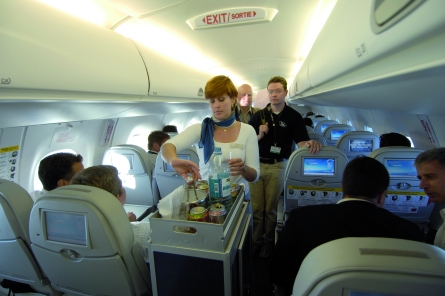Schedule slips
According to Flight’s online news service Air Transport Intelligence, hardware and software problems have been the source of delivery slips in the early days and schedule hits even now. After putting the aircraft to work on high-frequency service between Boston and New York Kennedy later in 2005, JetBlue admitted in early 2006 that its on-time reliability rates were “a few percentage points less” than its Airbus A320 aircraft, a problem linked to “familiarity issues” with the aircraft, including pilots not being approved for low-visibility operations.
This year has brought a new set of challenges. After a JetBlue E-190 rear cargo door opened just after take-off in March and an Air Canada E-170 front cargo door was discovered to be open on the ground, the US Federal Aviation Administration issued an emergency airworthiness directive on the E-Jet family.
JetBlue’s software and other mechanical problems have been more tedious. The carrier in March decided to ground its fleet of 26 aircraft, two aircraft at a time, to correct persistent software glitches not related to the Honeywell avionics and to install new slat wiring harnesses, upgraded hydraulic fuel pumps and other refinements, according to Embraer. The carrier contracted ExpressJet Airlines to operate four Embraer ERJ-145s in support of two lines of E-190 flying. The E-190s were cycled through a one-day modification line in Nashville, Tennessee.
Air Transport Intelligence reports that the software changeout is scheduled to be finished this month, although JetBlue will not confirm if that is the case.
The E-195 is the largest E-Jet model and was the last to enter service, with deliveries beginning to launch operator Flybe in September 2006. The UK regional airline signed an order for 14 E-195s, plus 12 options, in June
2005 to replace its ageing fleet of BAe 146s, and its first aircraft entered service on 18 September last year. This was less than three weeks after the airline’s general manger jets Bob Horton had ferried the twinjet to the airline’s Exeter base from São José dos Campos via Recife and the Cape Verde Islands.
“From the order in mid-2005 to the first delivery, Embraer’s timescales were spot on,” says Simon Chance, Flybe’s head of special projects and who is responsible for the technical aspects of the E-195’s introduction. He adds that the airline’s first aircraft (G-FBEA) had been the E-195 flight-test airframe, and had accumulated extensive test flight hours, so was delivered with new engines.
“We were impressed with how little was wrong with the aircraft when we did our pre-delivery inspection, compared to our experience with other aircraft types,” says Chance.
The airline now has three of the 118-seaters (one-class) in service. Although the batch from aircraft two to five has been delayed – mainly due to production issues – the carrier has been extremely impressed with the E-195’s mature behaviour. “We’ve had very few problems with the aircraft and Embraer’s support effort has been excellent,” says Flybe engineering director Stefan Kontorravdis.
|
|---|
Passengers like the four-abreast cabin, although there have been some issues with temperature control |
Delivery delays
“Our original plan was to receive one aircraft every two months. However, the second aircraft arrived about six weeks late and things won’t be back on track until July,” says Chance. “Embraer keep us aware of the slips upfront and they have a clear date when they will recover the schedule.”
These delays were primarily due to lagging production of the aircraft’s wings, a process Embraer has now taken over from partner company, Kawasaki Heavy Industries’ subsidiary in Brazil, says the airframer.
While the delay has been frustrating and has meant that the airline has had to retain some of its BAe 146s longer than planned, Chance says that Embraer has been proactive in keeping it informed of delivery schedule changes. “The rescheduled dates Embraer gives us are always spot on,” he says.
Kontorravdis says that Embraer made sure that the E-195’s “four key vendors”
attended its base during the period from “minus 30 days to plus 60 days” for the introduction of the first aircraft. “We had heavy representation from Embraer, General Electric, Hamilton Sundstrand and Parker, as well as Liebherr and Honeywell.”
Now the fleet is growing, Flybe has an Embraer field service representative who has been “very good”, while a customer account manager visits “frequently”.
“We used the first aircraft on short domestic routes such as Birmingham-Glasgow to accrue sectors for crews to enable them to get rid of their ‘new’ rating,” says Horton. With three aircraft now in service, one is operating from Birmingham mainly on domestic services to assist with accruing flightcrew experience, while the others are flying from Flybe’s Exeter and Southampton bases. The airline is using the E-195 on its longer “sun-route” sectors such as to Malaga in southern Spain.
 |
|---|
Finnair's fleet comprises E-170s and E-190s |
Source: Flight International
























